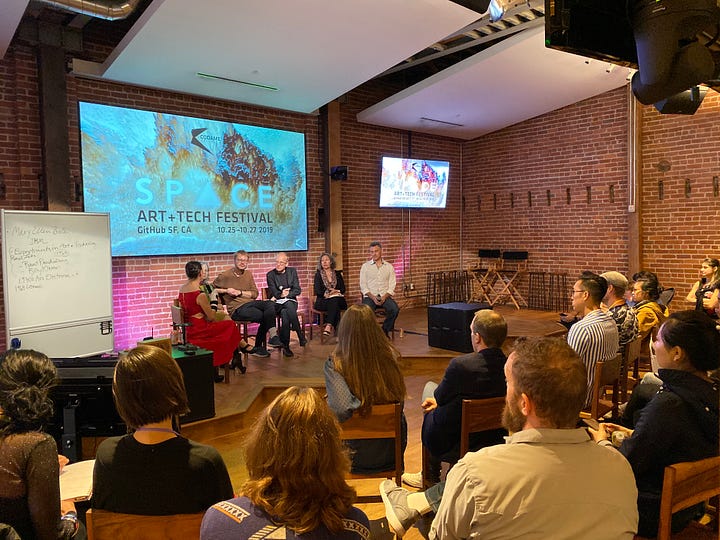Before Burning Man: The Early History of Macworld Party Culture
A parallel evolution of the Human/Digital Be-In and the Lost Art of In-Person Technology Demos
The Beginnings: A Fusion of Technology and Community
In 1985, Macworld emerged as more than just a platform for Apple to showcase its innovations; it became a cultural hub where technology, creativity, and community converged. Events like 1Fractal Design's concerts at The Fillmore West symbolized this era, blending art with technology in a celebration of the creative spirit of Apple's community. These gatherings transcended mere product showcases, evolving into vibrant celebrations of innovation and digital culture.




The Human Side of Technology History
Macworld created an ecosystem ripe for innovation, where startups and tech giants alike unveiled their latest and greatest. Beyond product launches, the event was pivotal for networking. WWDC developer parties exemplified this 2third party developer subculture, offering spaces for learning and collaboration. Informal gatherings, like those at The SoundFactory in San Francisco, further facilitated spontaneous interactions, crucial for the exchange of ideas and fostering human connections in the technology sector. Eddy Cue always made sure I had plenty of extra tickets to these parties to distribute to the rest of the design team.




AppleFest: Celebrating Community and Innovation in the Early Years of Personal Computing
AppleFest was a gathering in the 80s and 90s for fans and creators of Apple products. It also was a place where people showed off new apps and gadgets that worked with Apple computers. The event was all about learning, sharing cool stuff, and getting to know other Apple users. It helped build a lot of community around Apple's technology back when personal computing was just starting to take off.
The Rise and Fall of Steve Wozniak's US Festival
In 1982, Apple co-founder Steve Wozniak organized the 3US Festival to bring together top rock acts of the era like the Police, Tom Petty, and the Grateful Dead in a massive three-day music festival held in San Bernardino, aiming to recreate the communal spirit of Woodstock. Wozniak spent $12.5 million on the first festival and $20 million total over two years, bringing in crowds of over 200,000 people each day but losing tens of millions, making the US Festival a notable financial failure despite its ambitions of being the biggest rock festival in history and showcasing new technologies.


From Human Be-In to Digital Be-In: Technology Demos that served humanity
Parallel to Macworld was the Digital Be-In, a fixture in San Francisco since 1989 (spin off of the4Human Be-In), blending technology with social consciousness. Orchestrated by Michael Gosney and collaborators, it represented the counter-culture’s influence on the technology revolution. The Be-In showcased innovation in new media and internet technology, featuring creative tech applications, expert talks, and installations, culminating in a celebration of music and art.






The Shift to Online and the Loss of Humanity of In-Person Demos
The transition from physical events like Macworld to online-only formats marked a significant shift. This change meant more than the way technology was showcased; it represented a loss of the human side of technology demonstrations. In-person events allowed for hands-on experiences and real-time feedback, fostering a deeper connection between the innovator and the audience. The transition to online events, while far-reaching, couldn’t replicate the immediacy and impact of live demonstrations and face-to-face interactions.
Reviving a Tradition: Codame Art+Tech Festival
While digital events become the norm, festivals like Codame Art+Tech stand out as vital bastions of the in-person tech demonstration culture. I was brought in to photograph their event in 2019. Codame, much like the earlier incarnations of Macworld and the Digital Be-In, revives the spirit of hands-on, interactive experiences where art and technology intersect. This festival exemplifies the continued relevance and excitement of live tech demonstrations, offering a platform where innovators and creators can engage directly with an audience, showcasing their work in an environment that encourages real-time interaction and feedback. Here, the spontaneity and human connection lost in online events are rekindled, reminding us of the magic that occurs when people come together to share and experience the latest in technology and art, keeping the spirit of in-person demos vibrantly alive.




Conclusion: Balancing Human Progress with Emotional Intelligence
The history of Macworld parties and events like the Digital Be-In and Codame Art+Tech festival (see also Grey Area Foundation for the Arts) underscores the importance of maintaining the human element in technology. In an era leaning towards digital dominance and detachment, the value of in-person interactions, where emotional intelligence becomes a catalyst for human connection and creativity, becomes even more poignant. As the field of design continues to evolve, finding ways to balance progress with the essence of human experience remains a crucial challenge.
Afterthoughts…
(For more Internet nostalgia from the early 2000s)
These were some of the Internet Badges I was responsible for. The 'Created on a Macintosh.' badge would show up on all of our member generated HomePages as a badge of honor (people loved their Mac when these were popular and .Mac members consisted mostly of a large community of people who didn't mind showing off their brand loyalty to Apple). I designed the 'Get iTunes' and 'buy buttons' for artists to be able to direct others to their content inside the iTunes Music Store.




Instructions on how to access my design services:
Things I started, enjoy and can help with...
The best way to transform a company’s product line from the inside out is to lock 5 people in a room for three months and tell them not to come out until they’ve redesigned the company. Things I Started: 💌 Apple Webmail 🎁 Apple’s first gift card experience









